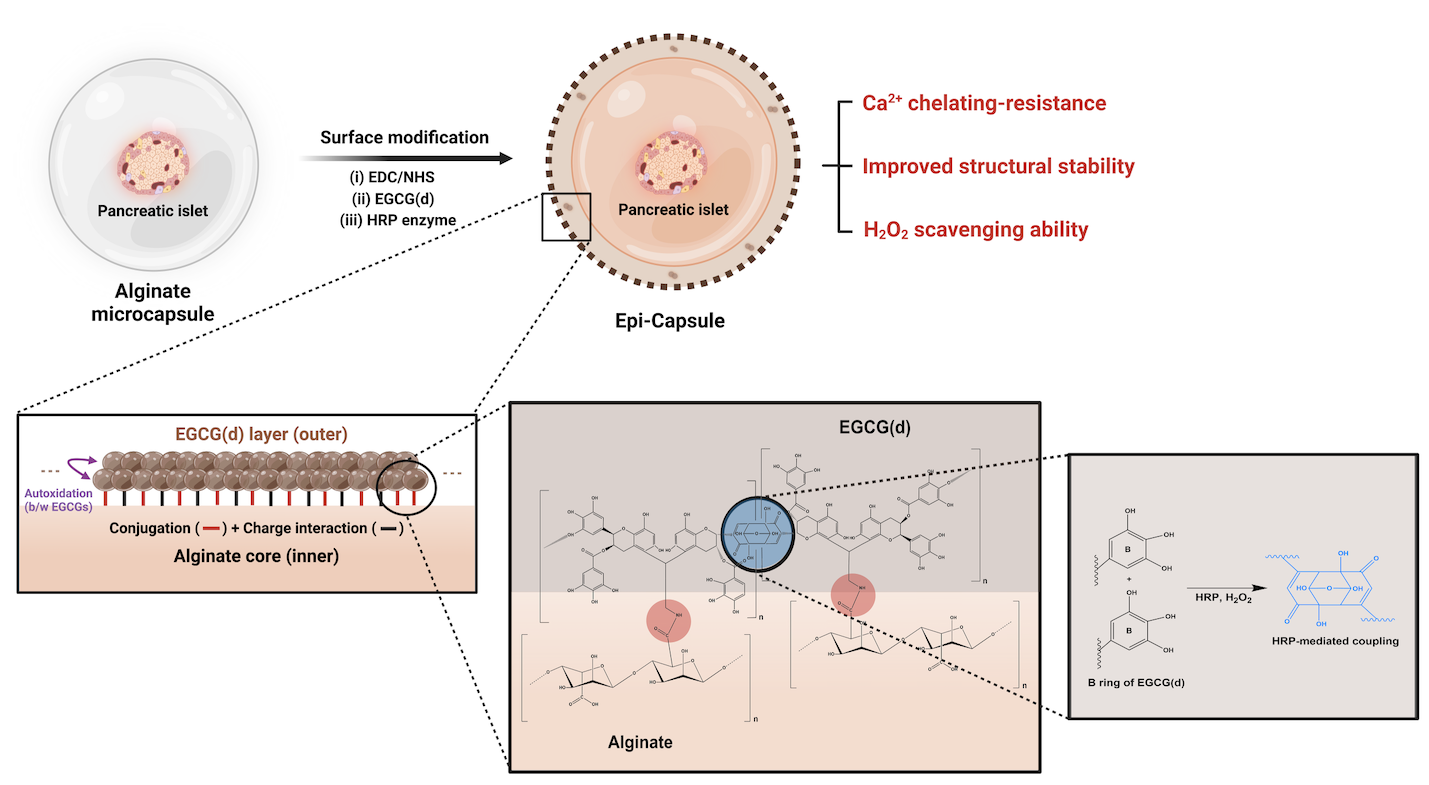Hanyang University
Surface modification of alginate-based microcapsules using ethylamine-bridged EGCG dimer improves the structural stability of microcapsules and supports islet-xenograft survival
Seon Mi Jang1, Jae Bin Lee1, Chae Rim Yoo1, Jae Kyung Park2, Ki Myung Choi2, Dong Yun Lee1,3,4,5.
1Bioengineering, Hanyang University, Seoul, Korea; 2Optipharm Co., Ltd., Cheongju, Korea; 3Institute of Nano Science and Technology (INST), Hanyang University, Seoul, Korea; 4Institute for Bioengineering and Biopharmaceutical Research (IBBR), Hanyang University, Seoul, Korea; 5Elixir Pharmatech, Seoul, Korea
Microencapsulation technology involves the formation of a semi-permeable immune-protective barrier using alginate to shield the islets from the host immune response while allowing essential survival factors such as oxygen, cell nutrients, glucose, and insulin to pass through the capsule membrane. Alginate-microcapsules are commonly used for the encapsulation of pancreatic islets to reduce the host immune response. However, the presence of large amounts of monovalent cations such as sodium ion (Na+) can lead to the exchange of these ions with divalent cations used for crosslinking, causing a sol-gel phase transition of the alginate microcapsule. This results in the gradual dissolution and swelling of the microcapsules in the body, leading to a shorter lifespan and exposure of the internal cells to the immune system. To address this limitation, a novel strategy for engineering alginate microcapsules by modifying their surface with ethylamine-bridged EGCG dimers (EGCG(d)) has been explored in this study.

EGCG, a catechin found in green tea at high levels, is characterized by the formation of a strong triple covalent bond between EGCGs via an oxidative reaction. We introduced EGCG(d) through an aldehyde-mediated condensation reaction, which selectively reacts with A ring of EGCG. This study involved modifying the surface of the alginate microcapsules by conjugating EGCG(d) (Al/EGCG(d)) through a carbodiimide-mediated coupling reaction. This created a stable layer of EGCG(d) on the outer surface of the microcapsule, formed through the bond between EGCGs mediated by the horseradish peroxidase (HRP) enzyme. The surface-modified (Al/EGCG(d)) microcapsules effectively inhibit structural destruction due to the diffusion of Ca2+ and ion exchange of conventional alginate microencapsulation. They also showed increased physical properties, and hydrogen peroxide scavenging ability arose from the EGCG(d) layer. Furthermore, using the HRP enzyme during surface modification was effective in increasing the stability of Al/EGCG(d) microcapsules. The efficacy of Oxi-Al/EGCG(d) microcapsules was tested in vivo, and it was demonstrated that they supported long-term survival (up to day 90) of xenotransplanted rat islets in diabetic mice and could maintain their glycemic functionality by providing resistance toward Ca2+ chelating degradation. This study presents a novel strategy for improving the structural stability of alginate-based encapsulation systems by creating Ca2+ chelating-resistant capsule surfaces, which could have important implications for the development of cell therapies for diabetes and other diseases.
References:
[1] Clayton, H.A. Islet microencapsulation: a review Acta Diabetologica. 1993; 30: 181-189
[2] P. de Vos. Alginate-based microcapsules for immunoisolation of pancreatic islets. Biomaterials . 2006; 27: 5603-17
[3] A. U. Ernst. Interconnected Toroidal Hydrogels for Islet Encapsulation. Adv Healthc Mater 2019; 8: e1900423
[4] A. D. Augst. Alginate hydrogels as biomaterials. Macromol Biosci 2006; 6: 623-33
[5] O. Khanna. Synthesis of multilayered alginate microcapsules for the sustained release of fibroblast growth factor-1. J Biomed Mater Res . 2010; 95: 632-40
[6] S. K. Bajpai. Investigation of swelling/degradation behaviour of alginate beads crosslinked with Ca2+ and Ba2+ ions. Reactive and Functional Polymers. 2004; 59: 129-140
[7] D. G. Nagle. Epigallocatechin-3-gallate (EGCG): chemical and biomedical perspectives. Phytochemistry 2006; 67: 1849-55
[8] F. Lee. Injectable Degradation-Resistant Hyaluronic Acid Hydrogels Cross-Linked via the Oxidative Coupling of Green Tea Catechin ACS Macro Lett . 2015; 4: 957-960
[9] F. Lee. Synthesis and bioactivity of a conjugate composed of green tea catechins and hyaluronic acid Polymer Chemistry. 2015; 6: 4462-4472
Lectures by Seon Mi Jang
| When | Session | Talk Title | Room |
|---|---|---|---|
|
Sun-29 07:30 - 08:25 |
Encapsulation of cellular transplants 2 | Surface modification of alginate-based microcapsules using ethylamine-bridged EGCG dimer improves the structural stability of microcapsules and supports islet-xenograft survival | Indigo D |
